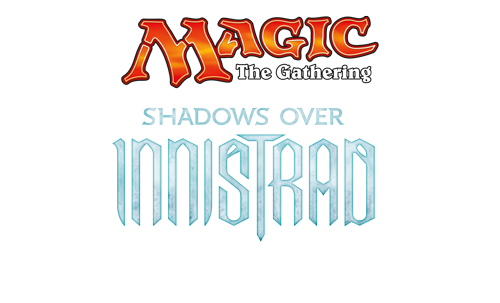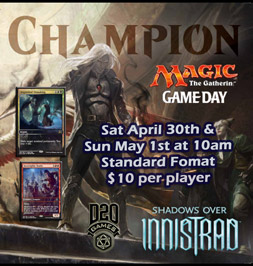Shadows over Innistrad
Everything old is, well nice and creepy again.;-) In Shadows Over Innistrad, we return to the glorious classic horror of Innistrad, a land where Vampires, Zombies and Horrors, try and hunt down humans, who grab their pitchforks and stand side by side with the Hero’s Spirits and Angels who fight on their side.
- Spoilers Here...Wizards starts leaking cards about 4 weeks before the set comes out…it’s fun to get a sneak peek…
The first Innistrad, ironically enough, was also the first set that came out when I took over the store, so the attachment is beyond how great the set was. (And it was great…Innistrad was the first set in a long time that Richard Garfield, the creator of Magic, was brought back to have a hand in, and it shows. Beyond the utter commitment to the storyline-i.e. no elves popping up in Bella Lugosi land, the mechanics of the set had a fun and directness to them that carried over to many of the sets that followed.) So stop smiling…this is supposed to be horrible (or Horror-ible). Hey…the puns are in the right Spirit!…Oh, stop barking at me, I know my jokes suck. (Yeah…I have teenagers…I can pull out bad Dad-puns all day long. Bring your groans…they are the music of the children of the night to me….)
Each new set introduces a small number of new abilities and brinks back a few oldies. Here is a rundown on these new (and some old) mechanics pulled from the wizards of the coast website.
DOUBLE-FACED CARDS
It wouldn’t be Innistrad if horrible things weren’t transforming into other horrible things, so double-faced cards make their return. Each double-faced card has two card faces and no back. Whoa! For the most part, they haven’t changed, although we have made a few rules tweaks that may pop up. If you’re comfortable with double-faced cards, feel go to the Double-Faced Cards Rules Changes section.
D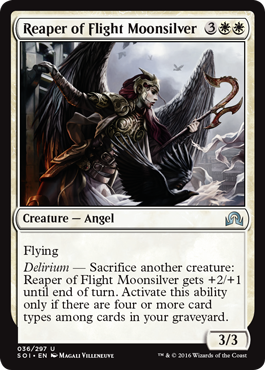 ELIRIUM
ELIRIUM
As advertised, Innistrad is a bleak world of horror and death, so a focus on the graveyard is to be expected. Delirium is a new ability word that highlights cards that get better if you have four or more card types represented in your graveyard. There are many different kinds of delirium abilities, including activated abilities such as the one found on Reaper of Flight Moonsilver.
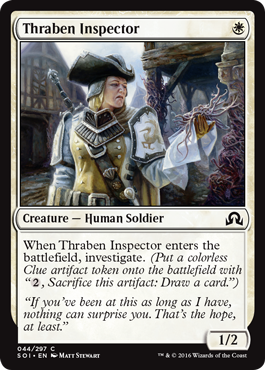 INVESTIGATE AND CLUES
INVESTIGATE AND CLUES
Mysteries permeate Innistrad like strange references permeate my writing. Zoinks! To solve these mysteries, you’ll need to investigate and follow the Clues.
MADNESS (A returning mechanic)
T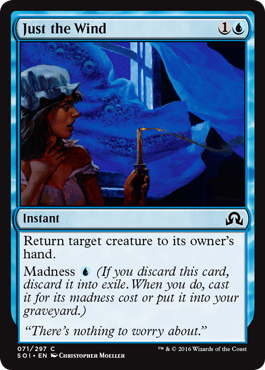 he next stop on our tour of brand new, never-before-seen Shadows over Innistrad abilities is madness, a returning ability you may have seen before. If you discard a card with madness, you exile it instead of putting it into your graveyard. This causes an ability to trigger. When that ability resolves, you can cast the spell for its madness cost. If you don’t cast the spell this way, it’s put into your graveyard. Well, all of that just sounds insane.
he next stop on our tour of brand new, never-before-seen Shadows over Innistrad abilities is madness, a returning ability you may have seen before. If you discard a card with madness, you exile it instead of putting it into your graveyard. This causes an ability to trigger. When that ability resolves, you can cast the spell for its madness cost. If you don’t cast the spell this way, it’s put into your graveyard. Well, all of that just sounds insane.
Note that the mandatory discard into exile is a small change from previous rules. Before, you could discard a card w
ith madness into your graveyard and skip the whole madness thing. This may be relevant with cards like Jace, Vryn’s Prodigy. That dude shows up a lot in this article for a card not in this set.
One cool thing about casting a spell using the madness ability is it doesn’t matter what its card types are. So if you manage to discard a creature card with madness during an opponent’s turn, you can cast that spell and maybe create a surprise blocker. The spell’s mana cost and converted mana cost don’t change. You’re just paying the madness cost instead.
SKULK
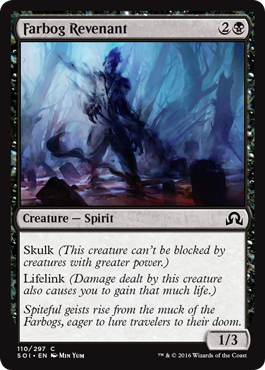 By now, I’m sure you’ve noticed that Innistrad is a bleak world of…Right, we’ve been over this. For some creatures, being all conspicuous isn’t the best plan. For those creatures, we present a new keyword: skulk. A creature with skulk can’t be blocked by any creature with greater power. Introducing Farbog Revenant.
By now, I’m sure you’ve noticed that Innistrad is a bleak world of…Right, we’ve been over this. For some creatures, being all conspicuous isn’t the best plan. For those creatures, we present a new keyword: skulk. A creature with skulk can’t be blocked by any creature with greater power. Introducing Farbog Revenant.
Aww…it’s totes adorbs, in an inky kind of way. With skulk, you consider the power of potential blockers only as blocks are being declared. If Farbog Revenant gets legally blocked by a 1-power creature, raising the power of the blocker won’t undo the block. But if your opponent has amassed beefy defenses, skulk can be an effective way to sneak damage in.
px; padding:5px 0 5px; margin:2px; width:100%; text-align:left;” ><a class=”powered-by-eb” style=”color: #dddddd; text-decoration: none;” target=”_blank” href=”http://www.eventbrite.com/r/etckt”>Powered by Eventbrite</a></div></div>]

